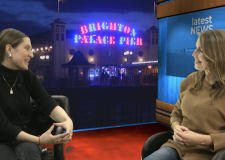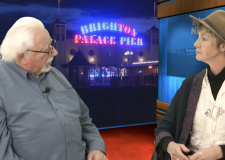Portzed architect spells out vision to Regency Society lecture in Brighton
The architect behind a controversial project on the edge of Shoreham Harbour spelt out his vision at a Regency Society lecture in Brighton on Wednesday evening (11 January).
Bill Dunster, one of two architects involved in designing Portzed, explained the project’s green credentials to audience of more than a hundred people.
Mr Dunster praised the developer Colin Brace, of Boho Green, for resisting the temptation to apply to build a solid block like the one approved for the site next door.
He said that Mr Brace had instead opted for six less dense blocks adding: “Planning permission has already been granted for a three-and-a-half storey slab.
“We wanted to build something that allowed views through to the open horizon.
 “It would have been very easy to come up with a continuation of the scheme that has already been granted permission to the east and block all views of the harbour forever.
“It would have been very easy to come up with a continuation of the scheme that has already been granted permission to the east and block all views of the harbour forever.
“Colin Brace is to be congratulated for not doing that.”
He said that the lower density and the exacting environmental standards would cost the developer money and reduce potential profits.
The scheme has, though, attracted opposition from people living in Kingsway and the roads behind.
Those who live closest to the site fear that the size and scale of the scheme will mean a loss of sunlight and a loss of their views.
Members of the Kingsway And West Hove Residents Association (KAWHRA) attended the meeting at City College Brighton and Hove in Pelham Street, Brighton, and some asked questions.
Regency Society chair Mary McKean said, when introducing Mr Dunster, that KAWHRA had reiterated before the meeting that it opposed the Portzed scheme – not “zero energy development”. The “zed” in Portzed stands for zero energy development.
Mr Dunster conceded: “There will be a 5 per cent reduction in sun hours … but it will be unnoticeable in terms of solar generation.”
He also said that people who lived in the 1930s houses typical of the area would get a better return from insulating their homes rather than installing solar panels.
He defended the original design, with its arrays of helical wind turbines, although these have been dropped after opposition. But he said that he hoped that they might be added at a later date.
Mr Dunster, who is Professor of Zero Carbon Urbanism at University College London, said: “We have to futureproof buildings. We try to make them simple and make them last a very long time.”
He explained many of the technical features that would enable Portzed to achieve Code 6 status judged against the Code for Sustainable Homes – even without wind turbines.
These included solar thermal collectors, passive heat recovery ventilation systems, photovoltaic cells, cladding and small biomass combined heat and power units.
He talked about using thermal physics and aerodynamic design principles.
He said: “Portzed is trying to show how the Code for Sustainable Homes can work.
“We can make a Code 6 homes and even make them desirable so that local authorities can demand them without developers and architects foaming at the mouth.”
The code is due to become compulsory in 2016 but he was concerned that ministers might put back the deadline.
He raised another laugh – even among his opponents – when he talked about sustainable living and said: “Probably the best thing you can do is to have a vegetarian lifestyle, eating predominantly locally grown produce and go and buy your food on a bicycle with a rucksack.”
More contentiously he said: “Walking along Kingsway is a rather depressing experience.
He praised the aesthetics of the Portzed design, developed with local architect Alan Phillips.
Mr Dunster also said: “It’s very important if someone is developing their land that they should provide homes for a lot of people.”
Portzed would provide 67 homes, he said, some of them available for social housing, as well as shops and office space. Electric-powered bicycles would be made at the site.
The development is expected to create dozens of permanent jobs on top of several dozen during the construction phase.
It also expected to be the first phase of related developments at the port – in terms of buildings and employment opportunities – and as such was a vital scheme.
A member of Hove Civic Society spoke up in favour of the project while Valerie Paynter, of Save Hove, spoke about alternative ideas to improve access to the harbour.
One of the biggest constraints to development there has been the poor access for transport leaving and entering the harbour area.
The Portzed planning application was submitted to Brighton and Hove City Council over a year ago.
In the autumn the council’s Planning Committee was told that they were due to discuss the application at a coming meeting.
That date has passed and no alternative date for a decision has been made public.
In the meantime, behind the scenes talks are still taking place.
And this week some insiders suggested that councillors would reach a verdict within six to eight weeks.




















